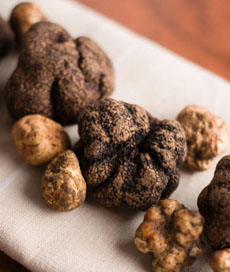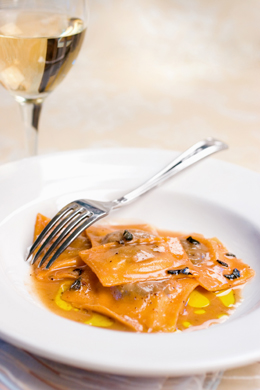
 Costlier than gold: the Périgord truffle of France and the white Alba truffle of the Piedmont, in Italy. Photo courtesy Mirepoix USA.
Costlier than gold: the Périgord truffle of France and the white Alba truffle of the Piedmont, in Italy. Photo courtesy Mirepoix USA.
|
|
|
KAREN HOCHMAN is Editorial Director of THE NIBBLE.
|
|
December 2006
Last Updated November 2013
|
 |
How To Buy Truffles
Page 3: What You Need To Know About Buying Fresh Truffles
This is Page 3 of a 12-page article. Click on the black links below to visit other pages.
The Life Span Of Truffles
|
Truffles need to be consumed within a few days after they’re harvested. If anyone gives you a fresh truffle, by all means, don’t save it! Cancel your dinner plans and decide how to cook it!
If you’re given (or fed) a fine truffle in the U.S., it may be a heavenly experience, but likely not as great an experience as it would be if you were in Périgord or Tuscany and it had been pulled out of the ground a day or two earlier. Most vegetables begin to wilt after harvesting, some faster than others. Truffles begin to lose their aroma: shipping overseas and getting into the retail channel adds days until the truffle gets onto your plate. In ten days, they couldn’t give it away free (well, O.K., free) to a savvy truffle buyer.
Here’s what we suggest: Indulge yourself gloriously by taking a truffle vacation in the fall or winter. Get together a group of friends for a custom gourmet tour (X.O. Travel Consultants, 1.212.947.5530, specializes in creating gourmet food and wine tours for groups of ten or more).
|
|

Sundried tomato ravioli stuffed with mushrooms in a light butter sauce, finished with truffle oil and black truffle shavings. Photo by Kelly Clne | IST. |
Chances are, you’ll decide this is the trip you want to make every year. Suddenly, you’ll find yourself with a whole new group of truffle-loving friends, and will be the toast of your town. Perhaps you’ll think of us and carry back a fresh truffle so we can share some of the experience.
Buying Truffles
Only buy truffles from a trusted purveyor who has expertise in truffles. Truffle fraud abounds and even luxury retailers who aren’t experts can be taken. Currently, Chinese truffles worth no more than wild mushrooms are being doctored and sold as Périgord truffles, worth more than $1,000 a pound. They look just like Périgord truffles, so it’s easy to get taken. While they have no natural scent and no more flavor than mushrooms, unscrupulous dealers nest them with genuine truffles, so they pick up the aroma. So they may pass the sniff test, but you’ll be very disappointed with the flavor—you’ll have bought very expensive mushrooms.
Experts judge not only the aroma, but examine the flesh for color and firmness, via a small cut in the truffle. While it’s tempting to want to save money on something so expensive, there are no good “bargain truffles.” There are, however, a lot of people who get taken every year, buying flat-tasting truffles that still costs a large amount of money.
- Truffles do not win beauty contests: They are bumpy and ugly. Distorted shapes do not imply inferior taste, but simply mean that while the truffle was growing underground, it hit a rock or other obstacle and needed to grow around it. It is harvesting at peak maturity that makes a great truffle.
- Good truffles are gathered at the height of maturity; their aroma and savory qualities deteriorate 10 days after they are dug up. The first question to ask your purveyor is, when did these arrive in the store, and when were they harvested (he or she may not know the latter, but should).
- The sniff test works. If there is no wonderful aroma, or it is faint, or mildewy or otherwise “off,” pass them by. At these prices, you should be overwhelmed with the strong, musky scent of the truffles.
- Select truffles that are 30 to 40 grams in size, 1 to 1.4 ounces, what would be an Extra Grade truffle. In France, truffles are graded Extra, Category 1, Category 2 and Unclassified. There are both weight and aesthetic considerations. Extra truffles must weigh a minimum of 30 grams and be the size of a ping-pong ball, with a similarly round shape; they must have “very slight” defects. However, experts point out that we should not be too hasty to judge an imperfectly-shaped truffle because often, the most perfect looking, round truffles are those that are picked while still green, and will never develop their full aroma potential. While you can consider a Category 1 truffle, small truffles are hard to handle and very large truffles have a lower percentage of surface area which is where aroma is most concentrated. Thus, the publicity over the largest truffle, purchased by one restaurant or another for many thousands of dollars, is just that—publicity to get people into the restaurant, than great-quality truffle that will create a memorable dish.
Continue To Page 4: Storing & Handling Truffles
Go To The Article Index Above
Lifestyle Direct, Inc. All rights reserved. Images are the copyright of their respective owners.

|





